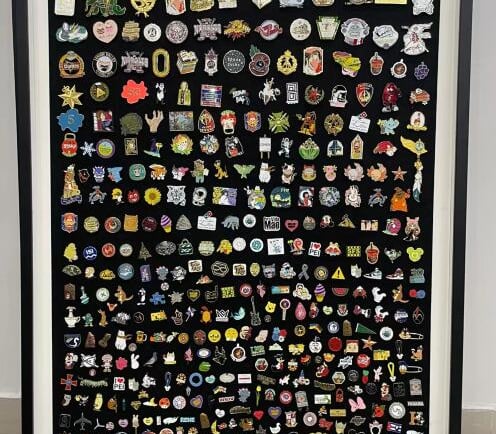Guide to Successful Enamel Pin Design
Learn how to create visually striking and manufacturable enamel pins with our detailed design guide. Understand the possibilities and limitations of enamel pin design for your next project.


Enamel Pin Types
Soft Enamel:
Soft enamel pins have raised metal lines with recessed enamel. The enamel is applied and baked, giving the pin a textured, tactile feel. Soft enamel often produces vibrant colors due to the recessed areas.
Hard Enamel:
Hard enamel pins are polished flat after the enamel is applied, resulting in a smooth, glossy finish. They are more durable and convey a higher perceived quality.
The Pin Production Process
Enamel pins are primarily made of two elements: plated metal and enamel paint.
Artwork to Die: Your artwork is used to create a die that stamps your design into a sheet of high-quality metal. The metal is then cut along the outline of your design. Keep your design bold and simple, as intricate details may not translate well at small pin sizes.
Plating and Polishing: The cutout pin is plated in a finish of your choice—gold, silver, or black nickel (most popular). Raised areas are polished to a high-quality shine, and recessed areas are filled with enamel paint.
Color Matching: Use the Pantone Solid Coated guide to match colors across production batches. Limit your color palette and ensure each color is enclosed by metal lines. High contrast between colors improves legibility and visual appeal.
Setting Enamel: Enamel is baked at high temperatures to set. Optional finishes, such as resin domes, may be added afterward.
Technical Specifications
Size: Pins typically range from 0.75 to 2 inches. Consider how your design will look at these dimensions.
Minimum Raised Metal Line Thickness: 0.3 mm. Lines thinner than this may not be visible or durable.
Spacing / Minimum Areas of Color: Ensure at least 0.3 mm between different elements to prevent color bleeding.
Text Size: Minimum recommended font size is 5 pt for plain fonts like Helvetica. More complex fonts require larger sizes.
Text Metal Areas: Raised metal for text should be no thinner than 0.2 mm, and any recessed color areas should be no smaller than 0.3 mm.
Pantone Color Matching
For consistent color reproduction:
Use the Pantone Solid Coated guide.
Indicate which areas of your design should use specific Pantone colors in your artwork or order instructions.
Access Pantone’s color explorer here: Pantone Color Explorer
Design Software Recommendations
Vector Software: Use vector-based tools like Adobe Illustrator or Inkscape. Vector files (.ai, .eps, .svg) scale without loss of quality.
Layers: Organize your design using layers to separate elements and colors, simplifying the manufacturing process.
Designing for Production
Metal Borders: Each color in a pin is separated by a metal border. Design with these borders in mind.
Plating Options: Gold, silver, or black nickel plating can affect the final look.
Back Stamps: Include a back stamp (text or logo) for branding or informational purposes.
Review and Proofing
Digital Proof: Manufacturers provide a digital proof for review. Check carefully for accuracy.
Sample Pin: For large orders, request a sample pin to ensure quality and that your design translates well to the final product.
Quick Reference
Minimum raised metal line thickness: 0.3 mm
Minimum recessed enamel area: 0.3 mm
Minimum font size: 5 pt (plain font like Helvetica)
Convert all text to outlines
Use Pantone Solid Coated for accurate colors
